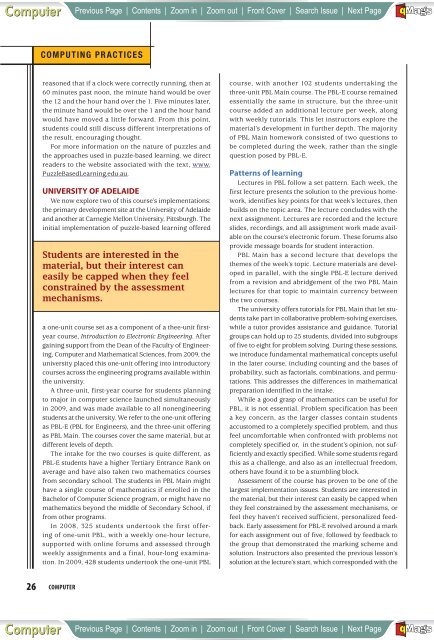computing lives - FTP Directory Listing
computing lives - FTP Directory Listing
computing lives - FTP Directory Listing
Create successful ePaper yourself
Turn your PDF publications into a flip-book with our unique Google optimized e-Paper software.
A<br />
Computer Previous Page | Contents | Zoom in | Zoom out | Front Cover | Search Issue | Next Page M S BE<br />
aG<br />
F<br />
26<br />
COMPUTING PRACTICES<br />
reasoned that if a clock were correctly running, then at<br />
60 minutes past noon, the minute hand would be over<br />
the 12 and the hour hand over the 1. Five minutes later,<br />
the minute hand would be over the 1 and the hour hand<br />
would have moved a little forward. From this point,<br />
students could still discuss different interpretations of<br />
the result, encouraging thought.<br />
For more information on the nature of puzzles and<br />
the approaches used in puzzle-based learning, we direct<br />
readers to the website associated with the text, ____<br />
www.<br />
PuzzleBasedLearning.edu.au.<br />
___________________<br />
UNIVERSITY OF ADELAIDE<br />
We now explore two of this course’s implementations:<br />
the primary development site at the University of Adelaide<br />
and another at Carnegie Mellon University, Pittsburgh. The<br />
initial implementation of puzzle-based learning offered<br />
Students are interested in the<br />
material, but their interest can<br />
easily be capped when they feel<br />
constrained by the assessment<br />
mechanisms.<br />
a one-unit course set as a component of a thee-unit firstyear<br />
course, Introduction to Electronic Engineering. After<br />
gaining support from the Dean of the Faculty of Engineering,<br />
Computer and Mathematical Sciences, from 2009, the<br />
university placed this one-unit offering into introductory<br />
courses across the engineering programs available within<br />
the university.<br />
A three-unit, first-year course for students planning<br />
to major in computer science launched simultaneously<br />
in 2009, and was made available to all nonengineering<br />
students at the university. We refer to the one-unit offering<br />
as PBL-E (PBL for Engineers), and the three-unit offering<br />
as PBL Main. The courses cover the same material, but at<br />
different levels of depth.<br />
The intake for the two courses is quite different, as<br />
PBL-E students have a higher Tertiary Entrance Rank on<br />
average and have also taken two mathematics courses<br />
from secondary school. The students in PBL Main might<br />
have a single course of mathematics if enrolled in the<br />
Bachelor of Computer Science program, or might have no<br />
mathematics beyond the middle of Secondary School, if<br />
from other programs.<br />
In 2008, 325 students undertook the first offering<br />
of one-unit PBL, with a weekly one-hour lecture,<br />
supported with online forums and assessed through<br />
weekly assignments and a final, hour-long examination.<br />
In 2009, 428 students undertook the one-unit PBL<br />
COMPUTER<br />
course, with another 102 students undertaking the<br />
three-unit PBL Main course. The PBL-E course remained<br />
essentially the same in structure, but the three-unit<br />
course added an additional lecture per week, along<br />
with weekly tutorials. This let instructors explore the<br />
material’s development in further depth. The majority<br />
of PBL Main homework consisted of two questions to<br />
be completed during the week, rather than the single<br />
question posed by PBL-E.<br />
Patterns of learning<br />
Lectures in PBL follow a set pattern. Each week, the<br />
first lecture presents the solution to the previous homework,<br />
identifies key points for that week’s lectures, then<br />
builds on the topic area. The lecture concludes with the<br />
next assignment. Lectures are recorded and the lecture<br />
slides, recordings, and all assignment work made available<br />
on the course’s electronic forum. These forums also<br />
provide message boards for student interaction.<br />
PBL Main has a second lecture that develops the<br />
themes of the week’s topic. Lecture materials are developed<br />
in parallel, with the single PBL-E lecture derived<br />
from a revision and abridgement of the two PBL Main<br />
lectures for that topic to maintain currency between<br />
the two courses.<br />
The university offers tutorials for PBL Main that let students<br />
take part in collaborative problem-solving exercises,<br />
while a tutor provides assistance and guidance. Tutorial<br />
groups can hold up to 25 students, divided into subgroups<br />
of five to eight for problem solving. During these sessions,<br />
we introduce fundamental mathematical concepts useful<br />
in the later course, including counting and the bases of<br />
probability, such as factorials, combinations, and permutations.<br />
This addresses the differences in mathematical<br />
preparation identified in the intake.<br />
While a good grasp of mathematics can be useful for<br />
PBL, it is not essential. Problem specification has been<br />
a key concern, as the larger classes contain students<br />
accustomed to a completely specified problem, and thus<br />
feel uncomfortable when confronted with problems not<br />
completely specified or, in the student’s opinion, not sufficiently<br />
and exactly specified. While some students regard<br />
this as a challenge, and also as an intellectual freedom,<br />
others have found it to be a stumbling block.<br />
Assessment of the course has proven to be one of the<br />
largest implementation issues. Students are interested in<br />
the material, but their interest can easily be capped when<br />
they feel constrained by the assessment mechanisms, or<br />
feel they haven’t received sufficient, personalized feedback.<br />
Early assessment for PBL-E revolved around a mark<br />
for each assignment out of five, followed by feedback to<br />
the group that demonstrated the marking scheme and<br />
solution. Instructors also presented the previous lesson’s<br />
solution at the lecture’s start, which corresponded with the<br />
A<br />
Computer Previous Page | Contents | Zoom in | Zoom out | Front Cover | Search Issue | Next Page M S BE<br />
aG<br />
F

















